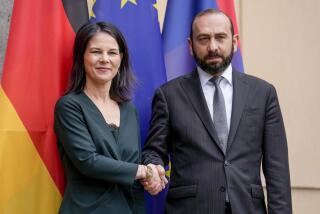No Easy Solutions to Resolve Long-Standing Caucasus Conflict
- Share via
A decade after the Armenian-Azerbaijani dispute over Nagorno-Karabakh erupted on the world scene in 1988, after thousands of deaths on both sides and years of futile negotiations, the conflict is still nowhere near a settlement. Sen. Mitch McConnell (R-Ky.), during a recent appropriations subcommittee hearing, told Secretary of State Madeleine Albright that he was “deeply skeptical” regarding the current peace process. He stressed that the United States has “huge interests” in the Caucasus, “particularly given the involvement of many of our companies in the Caspian Sea,” and encouraged Albright to make the issue “a higher priority.”
Albright acknowledged the region’s strategic importance and the Caspian oil factor and agreed that the peace process needed “more steam.” But “there is no quick and easy solution,” she cautioned.
That is an understatement. Azerbaijani President Heydar A. Aliyev and Armenia’s new president, Robert Kocharyan, met in Moscow in April and issued a joint statement confirming their “commitment to a peaceful settlement,” but their respective positions on the enclave’s drive for independence from Azerbaijan are as far apart as ever.
Azerbaijan still insists on having sovereignty over Nagorno-Karabakh, basing its position on the internationally recognized principle of territorial integrity. Nagorno-Karabakh is still angling for independence from Azeri authority, basing its position on the internationally recognized principle of self-determination.
The firmness of the Armenian position is symbolized by the fact that Armenia elected Kocharyan, who hails from the mountainous enclave, in a special poll on March 30 following the Feb. 3 resignation of the unpopular previous president, Levon A. Ter-Petrosyan, who had given up on backing the enclave’s push for independence.
Ter-Petrosyan had raised hopes in Western capitals last September when he indicated that he accepted a “step by step” compromise plan favored by the United States and other principal powers in the Organization for Security and Cooperation in Europe. According to that plan, Armenian forces would withdraw from the Azerbaijani territories they captured outside Nagorno-Karabakh in return for an eventual settlement that would promise the 150,000 Armenians in the enclave “the highest degree of self-rule within Azerbaijan.”
But the resounding rejection of this approach in Nagorno-Karabakh and Armenia made it impossible for Ter-Petrosyan to deliver on his offer to compromise. Ter-Petrosyan continued to promote the plan and that finally led to his resignation.
Ter-Petrosyan’s demise was a disappointment for the U.S. and Western oil companies that want to see this issue resolved quickly since it is the main obstacle to exporting Azerbaijan’s oil. But the disappointment can become a useful lesson for finding a lasting solution, if the events of the past six months are interpreted correctly.
Kocharyan’s rise to power was backed by overwhelming public opinion not because he opposes all compromise, but because he opposes the kind of compromise that Armenians believe would threaten their nation’s existence. The situation on the ground today and a long history of second-class status, pogroms and genocide under Turkish and Azeri rulers fuels the feeling among Armenians that their landlocked small country cannot develop a viable economy and ensure its national security without a symbiotic connection to Nagorno-Karabakh. For the Armenians, Nagorno-Karabakh is a question of life and death.
For the Azeris, Nagorno-Karabakh is a matter of understandable pride but it is not important for their security or prosperity. Azerbaijan is the biggest country in Trans-caucasia. It is blessed with a valuable shoreline along the Caspian Sea and it is fabulously rich in oil. Nagorno-Karabakh is an oil-less patch of mountains and a source of continuous conflict.
A credible case can been made that leaving the enclave inside Azerbaijan would continue to undermine Azerbaijan’s stability and threaten its oil industry. The history of the region suggests that the best way to save the oil of the Caucasus from an ethnic inferno is to have a clean break between the Armenians of Nagorno-Karabakh and the government of Azerbaijan.
As always, flexibility is necessary from both sides if the peace process is to move forward. But as Albright tries to carry out her promise to “rev it up a bit,” she will have to keep in mind that the fate of Kocharyan’s predecessor is a sobering signal that the kind of compromise the Armenians can accept is severely limited by the realities of geography and by the instinct to survive.
More to Read
Sign up for Essential California
The most important California stories and recommendations in your inbox every morning.
You may occasionally receive promotional content from the Los Angeles Times.










